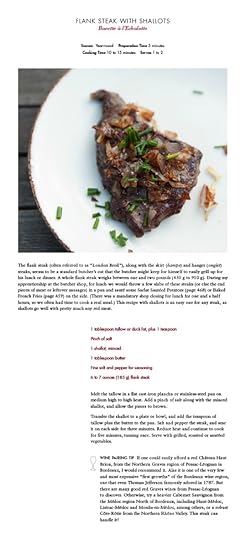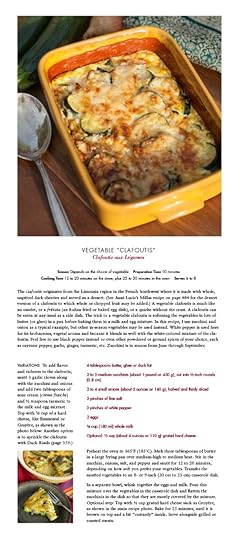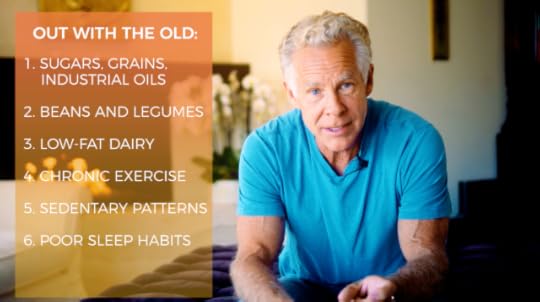Mark Sisson's Blog, page 138
June 14, 2018
A Book, A Deal, and A Contest: Introducing The Bordeaux Kitchen—A Masterwork of French Food, Wine and Culture
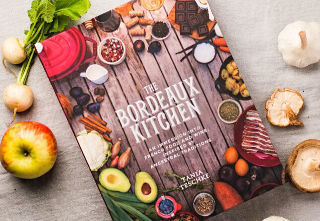 Of all the books I’ve been involved with over the past decade, including my own titles, I have to say this one is simply unsurpassed in the level of depth and detail. This book is Tania’s life’s work, and her passion and comprehensive education spills out onto every page. The incredibly informative writing and phenomenal photography was all her, and she went all-in to the extent you rarely encounter. This book literally honors Primal Blueprint Law #4: Lift Heavy Things.
Of all the books I’ve been involved with over the past decade, including my own titles, I have to say this one is simply unsurpassed in the level of depth and detail. This book is Tania’s life’s work, and her passion and comprehensive education spills out onto every page. The incredibly informative writing and phenomenal photography was all her, and she went all-in to the extent you rarely encounter. This book literally honors Primal Blueprint Law #4: Lift Heavy Things.
The Bordeaux Kitchen chronicles Tania’s journey through wine school in Bordeaux, a butchery apprenticeship, and the gathering of her vast treasure trove of recipes inspired by French chefs, friends and grandmothers. Tania transports you to the culinarily-rich French Southwest and demonstrates how “ancestral,” nutrient-dense, grain-free French recipes are optimal for nourishing your body and mind. Highlighting the latest research in ancestral health, The Bordeaux Kitchen enlightens you about the path to healing many modern-day, chronic maladies caused by nutrient-deficient diets. This is another area of deep experience and expertise with Tania, as her ancestral health journey has been informed and inspired by debilitating chronic illness likely caused by gut dysfunction from exposure in her world travels (FYI, Kazakhstan is a bad spot for an emergency appendectomy).
Sit back, peruse the beautiful recipes and photos and drink in the observations Tania herself shares with us today about French ancestral food culture. Her words, and her book, underscore for me how much is missing from our daily experience in the kitchen. The significance of ancestral eating isn’t only about a menu—but our relationship to food itself.
Finally, don’t miss the special Mark’s Daily Apple deal I’m offering for Tania’s masterpiece book….
Unplugging From Fast Food Culture, French StyleIn the US, it’s hard to resist the convenience of the 24-hour grocery store, instant foods, pre-chopped fruits and vegetables, measured meal ingredients delivered to your door, etc. This consumer-driven world has become woven into our expectations, such that stepping out of this paradigm seems nigh to impossible; it’s just what everybody does, right? It took me living overseas to realize that you can step out. You don’t have to live by the rules of consumer marketing.
In my case, living overseas, and especially in France, helped me to escape the modern barrage of marketing messages and find a rhythm of life attuned to more timeless patterns. This involved buying food fresh rather than packaged, and often at the outdoor market rather than at the chain supermarket. It meant embracing full-fat animal products from quality sources rather than fearing rich foods. I learned that it’s worth the time to procure and prepare the whole, nutrient-dense foods that my family needs rather than to buy easily-accessible, highly-palatable foods that they might want. It was not easy at first, but this ancestrally-minded way of life eventually became routine. It also had clear results for my health and that of my family: fewer digestive problems, more stable moods, better concentration at work and school. This lifestyle worked much better than following the dubious guidance of ubiquitous branding and calculated messaging that is all around us in the U.S.
Advertisement AversionDuring my three years in Bordeaux, I actively sought to learn about French food (and wine) to broaden my repertoire and feed my family more than just chicken breasts and salmon steaks. I asked neighbors about their grandmothers’ recipes, followed winemakers through the seasons, visited nearby farmers and markets and found a common theme—the availability, quality, and nutrient value of foods and drink are determined by the seasons, soil, microbiome, and the type the inputs (grass or corn; organic or conventional; etc). How you procure, prepare, and consume the food or wine was also important. Going to farmer’s markets by foot or bike, savoring meals and wine with family and friends, seeking out seasonal and organic vegetables, artisanal cheeses, grass-fed meats, and local wines, as a means of connecting with a place – all of this mattered. At the same time, I was seeking answers to my own health issues and discovered the ancestral, primal, and Paleo health movements. I came to see that many culinary and cultural traditions of France were more in synch with these movements and ancestral rhythms than what I had known growing up in suburban America.
As I explored the mismatch between tradition and our modern day lives, questions came to me: What if the producing, procuring, preparing, cooking, and sharing of our food is just as important as the act of eating the food itself, whether we’re French, Korean, or American? Could our sense of community and connection be even more vital than getting that errand of “food shopping” checked off of our list? And how could I focus on feeding my family the most nutrient dense food, while supporting a sustainable food system and ignoring the irresistible tug of consumerism?
Honing a Sense of PurposeMore questions came to me, but so did a few answers: First, I prioritized (and still do) what was most important: Family time? Nutrient-dense food? A sustainable future for my children? I articulated the priority, then committed to looking at my time as economists look at money: What is the opportunity cost of everything I do that is not my top priority? I was determined to only spend money in ways that aligned with these values. Now, still, when it comes to food, I look at my choices thus: I will only put things in my body (or feed my family) with unrefined, whole, organic, seasonal foods, and/or, I will only support the kinds of farmers and agriculture that I believe in. While it may sound over-simplified, thinking in this way can have a profound impact on your life, as each choice you make adds up to create your lifestyle. It also has the nice side effect of honing your sense of purpose.
How I Did ItIf I went to a large grocery store, I limited myself to the organic aisles or bins and only bought packaged goods that I couldn’t make at home myself: olive oil, certain dried herbs, vinegar, chocolate, certain vegetables. For raw milk, butter, cheese, and other vegetables, I relied on farmers markets or the neighborhood organic store with seasonal selection standards. We tended to buy wine directly from the wine makers, since we were in Bordeaux, after all.
Most people, including me, cannot buy food only from one farmer or completely avoid supermarkets, but fall somewhere on the spectrum between growing your own food 100% on one end, and patronizing the big box stores 100% on the other end. Your commitment to your top priority will determine your outcome and your expectations, not to mention the expectations of those around you. By being deliberate in your choices, and setting up the consequent expectations, you are not only going to help your own well-being, but also help to nudge society toward a more sustainable food system, as you vote with your dollar. And you can do this wherever you are right now. Get to know your local butcher, visit farmer’s markets, make your own fermented vegetables and bone broths, and try to buy the less sought-after cuts of meat: slow-cooked chuck beef, fatty pork shoulder, nutrient-dense organ meats such as liver, heart, and kidneys. (You will find recipes for all of these in The Bordeaux Kitchen.)
To Market, To MarketThe French seem know all of this intuitively: They have prepared and eaten traditional foods like offal and slow-cooked meat cuts, sharing meals with friends and relatives – sometimes over a glass of wine – for generations. And they know that going to the market may take a bit more time and might even cost a bit more than a chain grocery store. But they are also aware that they have the choice, with every Euro, either to spend it at the market stall as loyal customers to a local farmer, or as a nameless consumer at a large grocery store chain. They know that the vibrancy of their community depends on their support of local farmers, wine growers, butchers, and cheese makers. At the same time, they know they will see their friends and neighbors at the market and be able catch up on the latest gossip and news, or just reconnect. Speaking with vendors, sampling sausages, and discussing the current crop of mushrooms or selection of seasonal fish is central to the experience. They walk, bike, carry groceries, move from stall to stall, from home to market and back. It is a deliberate ritual, repeated weekly, if not more frequently.
As I discuss in The Bordeaux Kitchen, in France, going to the “farmer’s market” is part and parcel to life. The French relish in this communal ritual of gathering at their local market for social connection as well as for buying fresh food. Living in Europe, and particularly living in the center of Bordeaux, I have had the great privilege of having the option to walk or bike to markets and organic grocery stores to do my shopping. As I recount in the book, I would come home feeling robbed of energy after a trip by car to the chain supermarket, but would come home feeling refreshed, if a bit shorter on time, after a visit to the nearby market on foot, having run into a friend, and chatted with the butcher about a recipe, or with the organic produce vendor about his business.
Life, UnpluggedBesides walking more and driving less, disengaging with colorful packaging and the ubiquitous marketing paradigm has helped me to focus on the real food and the real issues with respect to health. So has not watching television: If we don’t watch TV, we don’t see the stuff we didn’t need in the first place. Also, by not watching TV shows, my children also miss the commercials about cartoon character cereals, drive-through meals, and pop-up screen options in gas-guzzling mini-vans. We have so little time as it is, why should we let the entrancing colors of modern branding and repetitive marketing lead us into distraction from the real priorities in our lives? Had I not lived in France, I’m not sure that I would have discovered that children can use knives at a young age to cut their own steaks or duck breast, or that it is possible to walk to a store and feel more fulfilled than driving on the highway, just to get eggs and butter, or that getting to know my local wine maker, farmer, butcher, or vegetable vendor is a joy in itself, a cultural exchange of ideas that weaves our social fabric and is the foundation of a meaningful healthy life, yesterday, today, and beyond.
People Over PackagingThis narrowing of focus, stepping away from the colorful packaging, and ignoring messaging with dubious health claims, leads one instead to focus on Nature (the seasons) and people (connection). As I argue in The Bordeaux Kitchen, farmers and even butchers live by the seasons, and indeed none of us is exempt from these rhythms. The traditions handed down to us from past generations have been vital to survival, such as the disappearing culinary arts of rendering fats, butchering meats, growing food according to the seasons, eating animals nose-to-tail, remembering to slow down and share meals with family and friends.
Looking to our recent ancestors, we can better understand that nourishing one’s body is something much more sacred than grabbing a package, box, or bottle off of a store shelf. Indeed, the acts of procuring, preparing, cooking, eating, and sharing are all much more important than we give them credit: Anything that goes into our body ought to be more of a conscious ritual rather than just a mechanical habit. Regularly slowing down to share and savor each step in the process of a meal (I would call this the traditional French interpretation of “farm to table”) helps us rely less on the packaging and more on our relationships to ourselves, our bodies, our health, each other, our communities, our tribes, our families.
As we delve deeper into ancestral traditions and lifestyle practices, it is helpful to realize to what extent we are surrounded by a plastic world of marketing and packaging. In opposition to this marketing are our communal ties to each other in which we can find real meaning and true connection, love, health, and support.
Living in France helped me step out of that plastic paradigm and understand that our connections with each other are more important than the tasks at hand and how we get them done is more important than actually doing them.
In my book, The Bordeaux Kitchen, I address the kinds of issues discussed here, while also supplying the reader with traditional French recipes for everything from beef, fish, pork, and lamb to organ meats, to step-by-step procedures on how to butcher a whole chicken, fillet a whole fish, and render animal fats to use in cooking. In The Bordeaux Kitchen, I set out to show how you can procure, prepare, and enjoy real, nutrient-dense food by preparing things yourself that you might never have thought possible.
The Bordeaux Kitchen shows you how to understand food, to live, eat, and share, all in synch with the seasons and our natural rhythms. I show you how to make your own bacon and reveal some of the secrets to French cooking, such as having the right herbs or stocks available for flavoring, what utensils to use, and how to whip up sauces that seem so difficult but are not hard to make. I bring you into the homes of French cooks, or describe how they cooked in my kitchen, showing me their tips and tricks. I take you through a butchery apprenticeship, an exploration of the wines of France and their descriptors, and I give you loads of wine and food pairing tips. I explain how families can refocus their priorities, how to throw a wine tasting party, or how to cut, serve and enjoy cheese. There is so much to discover when you make the decision to do things yourself and not be swallowed up by the advertising madness that surrounds us.
What we can learn from the French, we can learn from all traditional cultures: surround yourself with your friends and family and eat food that you have prepared yourself and either grown yourself or sourced from farmers and vendors whose sustainable agricultural methods and business practices match your own values and priorities. The Bordeaux Kitchen stands at the intersection of ancestral tradition and modern life, providing founding principles to a rich life, not a quick-fix diet. Join me on this journey, and let The Bordeaux Kitchen be your guide.
A big thank you to Tania for sharing more of her experience behind the book in today’s post. The subtitle, An Immersion Into French Food and Wine, Inspired by Ancestral Traditions, describes the reading experience very well. This is a true immersion into arguably the richest gastronomic culture in the world. The Bordeaux Kitchen should be required reading for learning to savor life through cuisine.
Even if you just integrate a new recipe into the rotation now and then, The Bordeaux Kitchen can help expand your horizons in a wonderful new direction. While there are over 180 sumptuous and easy-to-follow recipes for seasonal and traditional French dishes, it can hardly be called just a cookbook. Along with showcasing classic French dishes like Beef Burgundy, Tania Teschke shows you how to prepare organ meats deliciously, cure your own bacon, and understand all the cuts of meat—taking the Primal approach to a whole new level of DIY in the kitchen, There are step-by-step tutorials with photos, suggestions on how to pair wine with food, tips on how to pick and cut French cheeses, and how to feed guests the French way. There is even Primal-style recommendations on feeding your family with intention and getting kids more involved in the family meals.
The Bordeaux Kitchen serves as a practical guide to using the right kitchen tools for the disappearing arts of filleting a fish, carving a chicken, and rendering fat. The beautiful illustrations and rich descriptive text will make you an expert in French wine and cuisine in no time and keep you aligned with the Primal/paleo/ancestral health principles that have exploded in popularity across the globe in recent years. Every home cook who loves food and sharing it with family and friends will be inspired by The Bordeaux Kitchen.
A Special Deal For Mark’s Daily Apple Readers
Order The Bordeaux Kitchen on PrimalBlueprint.com and receive a FREE Primal Kitchen® Avocado Spray Oil for all of your Primal cooking ventures. Just use code NEWBOOK at checkout. Offer expires 6/22/18 at midnight PDT. Limit one special offer per customer.
Now For the Contest
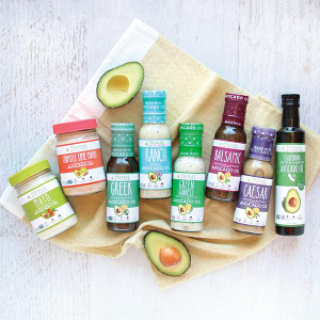 Leave a comment or question for me or Tania—any thought on ancestral eating or cooking, whether about skills, food or traditions. I’ll choose 1 winner at random to receive 6 months of the PRIMAL KITCHEN® Advanced Keto Kit.
Leave a comment or question for me or Tania—any thought on ancestral eating or cooking, whether about skills, food or traditions. I’ll choose 1 winner at random to receive 6 months of the PRIMAL KITCHEN® Advanced Keto Kit.
The Advanced Kit Includes everything you need to add heart-healthy monounsaturated fats to your diet and Primal inspiration to your home cooking: Primal Kitchen Mayo, Chipotle Lime Mayonnaise, Ranch, Green Goddess, Caesar, Balsamic and Greek Dressings & Marinades, California Extra Virgin Avocado Oil.
Contest ends midnight tonight PDT, June 14th, 2018.
Thanks for reading today. I’m thrilled for this book, and I’d love to hear your thoughts on the personal significance of ancestral eating traditions for you and your Primal lifestyle. Enjoy a couple of my favorite recipes from The Bordeaux Kitchen below. Be (and eat) well, everyone.

The post A Book, A Deal, and A Contest: Introducing The Bordeaux Kitchen—A Masterwork of French Food, Wine and Culture appeared first on Mark's Daily Apple.



June 13, 2018
Contest: Grokpose for $1000!
 The Prize:
The Prize:
$1000 gift certificate to PrimalBlueprint.com. What would a shopping spree look like for you? The things you’ve always wanted to try or maybe enjoy more regularly… Want a steady stream of PRIMAL KITCHEN bars—in all the varieties? Done. Maybe a year’s supply of Collagen Fuel? Done. How about enough PRIMAL KITCHEN
bars—in all the varieties? Done. Maybe a year’s supply of Collagen Fuel? Done. How about enough PRIMAL KITCHEN Mayo to fill up your bathtub? Maybe all the Primal Blueprint online courses? Also done. Today’s winner gets a thousand big ones to spend like cash and get whatever he or she wants at PrimalBlueprint.com.
Mayo to fill up your bathtub? Maybe all the Primal Blueprint online courses? Also done. Today’s winner gets a thousand big ones to spend like cash and get whatever he or she wants at PrimalBlueprint.com.
The Contest:
Pose like Grok. Take a photo of it. You know Grok, right? Here he is…

Pose like that. Whether in mid air, on the ground, hanging from the underside of a stairwell, or lying on the dirt. If your body roughly matches the positioning of Grok, you’re qualified. If you’ve got a spear, awesome. If you have some other representation of a spear, that’s fine too. If you’ve got an “air spear,” that’s acceptable as well. Creativity is encouraged. Once you’ve figured out how to do it, get someone to take a picture of you in your Grokpose. Then, post your photo to Instagram, tag @MarksDailyApple and use hashtag #GrokInTheWild in the post text so the Worker Bees and I can see your entry.
Need some more inspiration? Check out last year’s submissions here.
Don’t have an Instagram account? No problem, Email me the picture instead. Please use the email subject heading “Grokpose Submission.” Otherwise, there’s a good chance I may miss your submission.
Who is Eligible:
This one is global, so anyone can enter!
How A Winner Will Be Decided:
Photo submissions will be reviewed, and a select few will be posted toward the end of the Challenge. The Worker Bees and I will choose a list of finalists to be voted on by readers.
Deadline: June 25th, 2018, midnight PDT.
Fine Print:
MDA reserves the right to publish all submitted material.
Want to make fat loss easier?
Try the Definitive Guide for Troubleshooting Weight Loss for free here.
The post Contest: Grokpose for $1000! appeared first on Mark's Daily Apple.



Fasting versus Carb Restriction: Which Works Better for What Scenarios
 Both fasting and carb-restriction appear to operate along similar physiological pathways. Both lower carbs. Both increase fat-adaptation. Both have the potential to get you into ketosis. Both lower insulin and blood sugar.
Both fasting and carb-restriction appear to operate along similar physiological pathways. Both lower carbs. Both increase fat-adaptation. Both have the potential to get you into ketosis. Both lower insulin and blood sugar.
But is one better than the other? Are there certain scenarios in which an intermittent fasting protocol works better than a low-carb diet, and vice versa?
Let’s find out if the distinction matters.
And what scenarios are most impacted by any difference.
Fat Loss
Ketones, shmetones. Autophagy, shmautophagy. Cognitive decline, shmognitive shmecline. (Shall I keep going?) The number one reason anyone attempts either a carb-restricted diet or intermittent fasting is to lose body fat. We all know it’s true.
Carb restriction works well. That’s been well-documented. Sure, the results get a little fuzzy if you use “low-carb” diets with 35-40% of calories from carbs or enforce calorie-matched control diets, but legitimate ad-libitum low-carb diet studies where people are free to eat what they want find that subjects spontaneously reduce calories and lose body fat faster than with other diets.
Intermittent fasting has also been shown to work. In non-obese patients, alternate day fasting increased fat oxidation and weight loss. In obese patients, alternate day fasting was an effective way to lose weight; dietary adherence remained high throughout. In young overweight women, alternate day fasting was just as effective as caloric restriction at causing weight loss, and adherence to the former was easier than to the latter.
Intermittent fasting and carb-restriction are pathways to easy calorie restriction. Fasting removes the possibility of eating entirely. Carb restriction removes the least satiating macronutrient and increases the most satiating macronutrients. Both diets increase fat burning and, provided you eat adequate protein and lift some heavy things, preserve lean mass.
The trick is sustainability: If fasting makes you unfathomably hungry, it’s probably not going to help you lose weight. Anecdotally, I find that basic carb restriction helps the most people and is the best-tolerated.
Type 2 Diabetes
You just got back from the doctor and you have Type 2 diabetes. Or maybe you have “pre-diabetes.” Perhaps you haven’t been to the doctor yet, but tracking your blood sugar at home reveals some high postprandial numbers. Or maybe you have a strong family history of diabetes, and you’re looking to avoid it manifesting in you. Whatever the reason, you know that you need to make a dietary change.
First and foremost, type 2 diabetes is a type of “carb intolerance.”
Seven subjects with untreated type 2 diabetes either fasted for 3 days or went zero-carb for 3 days. What happened on day 3?
Overnight fasting glucose went from 196 to 160 (on zero carb) and 127 (fasting).
24 hour glucose dropped by 35% (zero carb) and 49% (fasting).
24 hour insulin dropped by 48% (zero carb) and 69% (fasting).
Both approaches worked. Fasting worked better, but you can’t just keep fasting indefinitely. At some point, you have to eat something.
A very recent study just came out on the effect of time restricted feeding (a type of IF) on prediabetes. This is also known as a compressed eating window. The compressed eating window in this study was six hours long, and it was an early one—from morning to the mid afternoon. They ate breakfast, skipped dinner. What happened?
The IFers improved insulin sensitivity, lowered fasting insulin, increased pancreatic beta cell function, and reported feeling less hunger at night. They had better blood pressure and lower oxidative stress. What’s most remarkable is they achieved all this despite not losing much weight. In previous IF studies, most of which paid no attention to the time of feeding, the benefits to people with diabetes or prediabetes were almost always dependent on weight loss.
The time of the day the fasting occurs is quite relevant. Skipping breakfast may not have the same effect as skipping dinner. If you’re using IF to treat high blood sugar, prediabetes, or full-blown type 2 diabetes, make sure you track your results and are willing to try fasting during different parts of the day.
Seizures
As far back as Hippocrates, fasting has been used to treat seizures. Ketogenic diets hit the seizure scene back in the early 1900s. Both approaches produce ketones, which appears to be the important factor. Other methods of increasing ketones, like taking supplementary ketones or eating medium chain triglycerides that convert to ketones, also reduce seizures. So, are both IF and low-carb/keto interchangeable when it comes to seizure reduction? A recent study suggests an answer:
Mice were separated into three diet groups. One group ate a ketogenic diet. Another group ate a regular lab diet. The final group combined the regular lab diet with intermittent fasting. After a couple weeks, researchers induced seizures by dosing the mice with a seizure-inducing agent or subjecting them to seizure-inducing electric shocks. Both the ketogenic diet group and the lab diet/IF group experienced relief from seizures in different ways. The keto group resisted the electric shock seizures but was vulnerable to the seizure agent. The lab/IF group resisted the seizure agent but fell prey to the electric shock.
If these results play out in humans, the best approach to combat seizures would be to do both: carb-restriction with intermittent fasting.
However, many seizure patients are children who still have a lot of growing to do. While ketogenic diets have been tested and shown to be safe and beneficial in these populations, regular fasting could have negative effects on growth and development. Best to stick with what’s known and safe. Adults who’ve got all their physical growing out of the way? Have at it.
Athletic Performance
Endurance athletes who aim to maximize their aerobic output and improve glycogen retention should do carb restriction and increase carbs for competitive events. This is known as “train low (carb), race high (carb),” and it’s a great way to teach your body to utilize its own stored body fat for energy for as long as possible during events and hold off on burning lots of glycogen until the last portion of the race. Done correctly, this method allows an athlete to have plenty of gas left in the tank when the rest of the pack is running on fumes.
Higher-intensity athletes who need/want to eat more carbs to replenish the glycogen stores they’re always emptying can’t do that on a carb-restricted diet—by definition. They may opt for a more carb-agnostic form of intermittent fasting. While intermittent fasting may not directly improve athleticism, it can certainly co-exist with it. One popular method of intermittent fasting is the Leangains approach:
Eat low-carb, higher-fat on rest days. You won’t be burning any glycogen, so there’s no need to eat carbs.
Eat higher-carb, lower-fat on training days. You’ll be burning through your glycogen, so it’s the perfect time to eat carbs because they’ll go directly to your muscles.
Fast for 16 hours a day with an 8 hour eating window. Try to put your training right around the time you break your fast.
Low-carbers can always modify their diets to include more carbs with training—sort of a cyclical ketogenic approach—but that ceases to be “strict low-carb.”
Cognitive Performance
One little-known effect of not eating is that it can improve our cognitive function thanks to ghrelin. Most people know ghrelin as a hunger hormone. It makes you want to eat. But ghrelin has other cool effects:
It’s neurotrophic, improving learning and memory.
It increases the dopamine response, potentially increasing the reward of goal achievement.
This makes sense when you think about the environment under which our ghrelin system evolved. Today, hunger means plodding over to the fridge for a snack. It means ordering a vat of chicken tikka masala from the comfort of your smartphone to be delivered to your door. Ghrelin doesn’t have to do much but make us hungry. For most of human history, hunger meant you had to creep through the wilderness, spear or bow or atlatl at the ready, taking care not to step on any twigs or make any sudden movements, following the tracks of your prey. You needed to be cunning, alert, on point, and prepared for anything and everything. Of course the hormone that makes us want to eat also makes us better at thinking and acting.
Low-carb doesn’t have the same effect. For one, you’re eating. The biggest ghrelin response will come from not eating. Two, low-carb meals are bigger reducers of ghrelin than high-carb meals. This probably explains by low-carb is such an effective way to reduce hunger. This doesn’t make carb restriction bad for cognitive function. Becoming a better fat-burner, generating ketone bodies, and not having to snack every two hours or else lose cognitive steam are all great ways to improve output and productivity. It just means you won’t see the same acute effects of a spike in ghrelin that you’d see fasting.
So, which is it?
If you want to lose body fat, control dysfunctional blood sugar responses, get more mental energy during the day, be better at burning fat and saving glycogen during workouts, and/or reduce treatment-resistant seizure activity, you’d be hard pressed to find a better pair of options than low-carb/keto and intermittent fasting.
Start with a baseline of carb restriction—whereby you restrict unnecessary carbohydrates, only consuming the ones you’ll use to fuel high-octane physical pursuits like CrossFit, lactation, and fetus construction—and try skipping a meal or two when you feel up to it. Maybe you never feel up to it. That’s fine.
Maybe you even go the opposite way. You can’t hack restricting carbohydrates, but you have no problem skipping meals on a regular basis.
The key thing is that you achieve extended periods of fat-burning and low insulin. Both IF and carb restriction achieve that.
That’s it for today, folks. Thanks for reading, take care, and leave your thoughts down below!

The post Fasting versus Carb Restriction: Which Works Better for What Scenarios appeared first on Mark's Daily Apple.



Grilled Chicken Salad
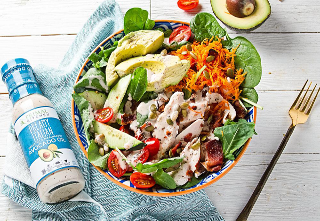 It’s Big-Ass Salad week, and we’ve got another healthy, hearty option for your Primal lunch or dinner menu. Try this tasty Mediterranean salad topped with Primal Kitchen® Dreamy Italian Dressing, served up with slices of avocado, cherry tomatoes and grilled chicken.
It’s Big-Ass Salad week, and we’ve got another healthy, hearty option for your Primal lunch or dinner menu. Try this tasty Mediterranean salad topped with Primal Kitchen® Dreamy Italian Dressing, served up with slices of avocado, cherry tomatoes and grilled chicken.
Throw this keto-friendly, high-nutrient salad together, and drizzle on our fragrant and delicious Primal Kitchen Dreamy Italian Dressing to your heart’s content. Filled with Mediterranean vibes, amazing flavor, and tons of healthy fats, this dressing is a guaranteed pantry staple and family-friendly favorite.
For more Primal Kitchen recipes and inspiration, check out the Primal Kitchen news and recipe blog.
Time: 35 min
Servings: 4
Ingredients
4 pieces boneless chicken
2 tablespoons Primal Kitchen Avocado Oil
1 teaspoon oregano
2 sprigs chopped rosemary
2 cups mixed greens
1 avocado (sliced)
1/3 cup cherry tomatoes
1/3 cup cucumbers
1/3 cup carrots
1/8 cup pumpkin seeds
1/4 cup bacon bits
Salt and pepper (to taste)
Primal Kitchen Dreamy Italian Dressing
Instructions
Place the chicken strips on a hot grill. Brush them with Primal Kitchen Avocado Oil, and sprinkle with oregano, chopped rosemary, salt and pepper.
Turn, the chicken strips over, and repeat. Grill until no longer pink.
Meanwhile, combine mixed greens, avocado, cherry tomatoes, cucumbers, carrots, pumpkin seeds, and bacon bits into four serving bowls.
Add slices of grilled chicken to each, and top with creamy Primal Kitchen Dreamy Italian Dressing.
Enjoy!


The post Grilled Chicken Salad appeared first on Mark's Daily Apple.



June 12, 2018
Big-Ass Salads—Worker Bee Style (and a Contest!)
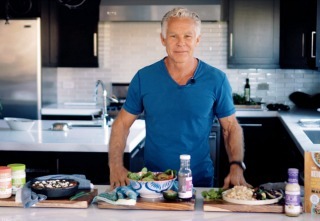 Nearly a decade ago when I described my daily lunch as a “Big-Ass Salad” I didn’t realize it would become a thing. But it has, and it’s taken on a life of its own here in the office (and even on YouTube). The advent of the Primal Kitchen® dressings have only made it more so, especially with the staff’s observations of how much dressing I tend to use. (Moderation isn’t always a good thing.)
Nearly a decade ago when I described my daily lunch as a “Big-Ass Salad” I didn’t realize it would become a thing. But it has, and it’s taken on a life of its own here in the office (and even on YouTube). The advent of the Primal Kitchen® dressings have only made it more so, especially with the staff’s observations of how much dressing I tend to use. (Moderation isn’t always a good thing.)
So, today the Bees decided to share their own “Big-Ass Salad” creations. To extend the theme even further, they want to see yours as well, and we’ve got a prize for one lucky Big-Ass winner.
Check out their creations below as well as the contest details.
Sabrina T., Content & Editorial Manager

Liz M., Social Media Director
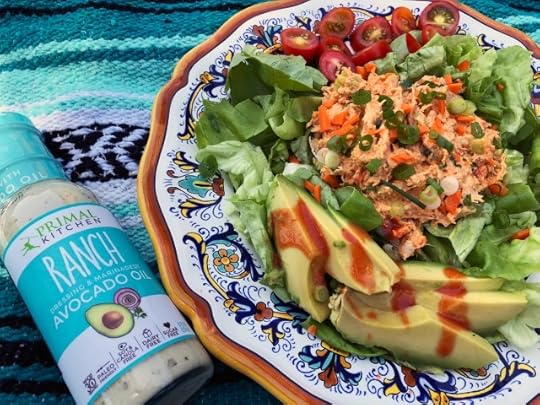
Ana G., Director of Marketing

Michelle F., Customer Service Manager

Annie M., Marketing Coordinator
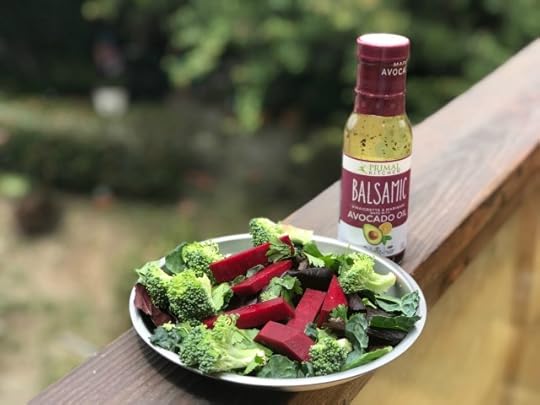
Aaron F., Co-Founder, Primal Health Coach Institute

Britt M., Customer Service Rep
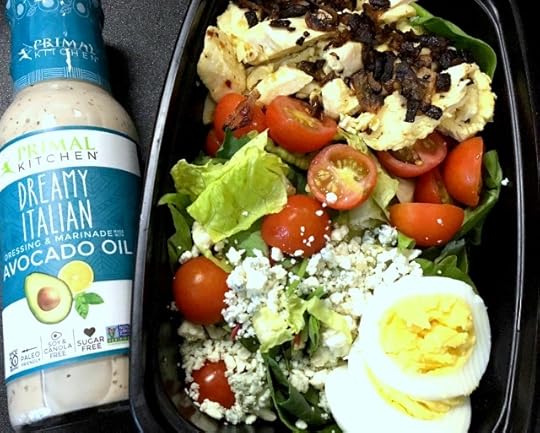
And if you all missed mine a while back, here’s a video for one of my recent favorites.
Now For the Contest…
The Bees and I want to see YOUR Big-Ass Salad creations!
Show us Grok’s best salad bowls. The pictures don’t have to be fancy, nor do they have to include anything from Primal Kitchen (although that’s cool if they do). Mad props go to the best photographers out there, but the winner will be selected in a random drawing, so don’t feel obliged to play “Keeping up with the Grokses.” Just post your photo to Instagram and tag @MarksDailyApple and @PrimalKitchenFoods as well as #PrimalReset and #BAS, so the Worker Bees and I can see your entry.
Don’t have an Instagram account? No problem. Email me the picture instead. Please use the email subject heading “Big-Ass Salad Submission.” Otherwise, there’s a good chance I may miss it.
The Prize:
Six months of Primal Kitchen Pantry Kits (6 kits), plus Katie French’s Paleo Cooking Bootcamp online course.
Who is Eligible:
This one is global, so anyone can enter!
How A Winner Will Be Decided:
A random drawing will be held among all entrants who submit adequate photos that match the intent of the contest.
Deadline: June 25th, 2018, midnight PDT
Fine Print:
MDA reserves the right to publish all submitted material.
There you go, everybody! We’re looking forward to seeing what you come up with. Have a great week.


The post Big-Ass Salads—Worker Bee Style (and a Contest!) appeared first on Mark's Daily Apple.



Top 10 Meal Prep Tips: So You Can Spend More Time Doing What You Really Love
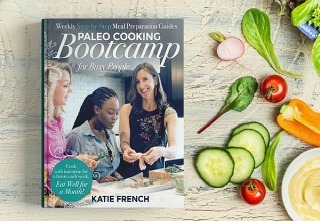
We’ve got some Worker Bee bites—and a contest—coming up later this morning, but in the meantime I’m happy to share a guest post with excellent tips for making your Challenge cooking easier and more efficient.
Today’s guest post is offered up by cooking coach extraordinaire, Katie French. She’s the author of the popular Paleo Cooking Bootcamp book and creator of the Paleo Cooking Bootcamp Multimedia online course, both offered through PrimalBlueprint.com.
As a cooking coach, I teach people how to make healthy eating sustainable. The recipe? What you eat must be satisfying, and it also has to be easy to prepare. Here are my top-10 tried and true meal prep. tips to help you simplify your weekly routine.
Shop One Day + Prep On a Different Day
Most people are overwhelmed by the thought of spending an entire day grocery shopping, and then cooking. So break it up! I really enjoy the farmer’s market, so I spend a nice Saturday morning cruising the farmer’s market to get my groceries (and lots of yummy samples!), then usually a quick stop at the grocery store for any pantry items I need that week, and then I still have the rest of my Saturday to play.
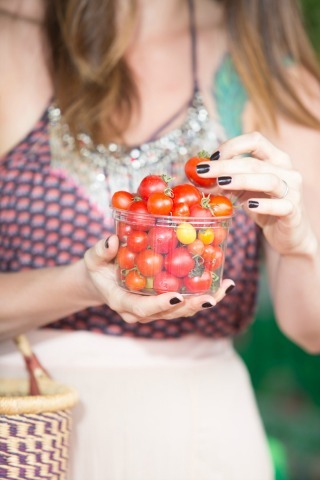 On Sunday, I carve out a couple of hours for cooking, usually in the morning, so that I still have plenty of time to relax and enjoy before the week starts again.
On Sunday, I carve out a couple of hours for cooking, usually in the morning, so that I still have plenty of time to relax and enjoy before the week starts again.
And if you have a really full weekend, try picking up your groceries on Friday after work, and, bonus: most grocery stores fully stock up on Fridays in anticipation of the weekend rush, so you will have the best selection of everything. Or, if you live in an area where they have grocery delivery services, just place your order online and bypass the grocery store completely that week!
Invest in Time Savings Kitchen Tools
My food processor slices, shreds and even dices and spiralizes in seconds. This saves me SO much time on my veggie prep each week!
Prep Veggies All at Once
If I have some extra time and I am feeling motivated after coming home from the farmer’s market/grocery store, I prep all my veggies that I will need for my recipes that week. You will be surprised at how much time you save on cooking when you already have your veggies prepped. And even if you don’t have time to prep. your veggies in advance, you can save time by prepping all your veggies at the start of your cooking session. As with any activity, batching your tasks saves time.
Shortcuts – Pre-Prepped Veggies
By all means take short cuts! Buy your veggies already prepped: I have seen riced cauliflower, spiralized veggie noodles, pre-peeled or pre-minced garlic, pre-cut broccoli florets, pre-peeled and sliced carrots, sliced mushrooms, and other pre-cut vegetable medleys.
Shortcut – Primal Kitchen® Condiments
Why would you make your own homemade Mayo when you can just buy a jar of delicious, healthy Primal Kitchen Mayo?! And Primal Kitchen’s delicious salad dressings elevate your meals and snacks without any extra time on your part: try Primal Kitchen’s Ranch Dressing as a dip for your raw veggies, or I always feel like I am indulging when I eat any salad that is drenched in Primal Kitchen’s Caesar Dressing. When healthy = easy, that is when eating healthy becomes a lifestyle.
Make a Double Batch, and Freeze
It is inevitable that some weeks you will struggle to find the time, or even the motivation, to meal prep. Help yourself out by filling your freezer with delicious, healthy meals that you can easily defrost and enjoy. This is not difficult to do, just make a double batch of a few recipes and freeze half of the portions. Your future (busy + tired) self will thank you.
Stock Your Pantry and Freezer with Easy to Make Meals
Figure out the recipes that you can always make from things on hand in your pantry or freezer. Here are some of my favorites: cassava flour for homemade tortillas (the only other ingredients I need are warm water, sea salt and avocado oil, which I also always have on hand); canned salmon or tuna and Primal Kitchen Mayo to make a salmon/tuna salad; and, frozen fruit and veggies and Primal Kitchen Collagen Fuel to make smoothies.
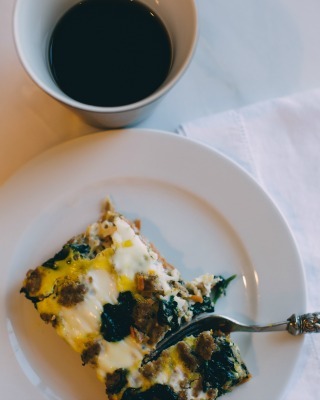 Tackle Your Most Difficult Meals First
Tackle Your Most Difficult Meals FirstThis tip is a golden nugget – if you don’t have time for a full week’s meal prep., or if you are unfamiliar with meal prep. and just want to make a small start, begin with prepping the one meal or snack of the day that is always the most difficult for you to stay on track with. For me, in my previous life as a litigation attorney, I was always most challenged by breakfast: I knew I needed to eat something, and that it needed to be healthy and nutrient-dense so I could keep my energy up as I started my day, so I would always pre-make a protein-filled portable breakfast for my week, like egg muffins with sausage and veggies. Once you hack your hardest meal of the day, it only gets easier.
Team Up
Teaming up to do any part of your weekly meal prep. makes it WAY more fun. Share recipes and meal plans, make the Farmer’s Market or grocery store a social outing, do your weekly cooking with family or friends, or even just prep. your veggies together. One of the reasons why my in-person Paleo Cooking Bootcamp classes were such a success was because people loved the experience of doing their weekly meal prep. in a group.
Get More Tips (and Support) With Paleo Cooking Bootcamp – Digital Program
After years of doing my own weekly meal prep. hustle when I worked as a Silicon Valley litigation attorney, I created a digital video program – Paleo Cooking Bootcamp, that takes all of the stress and guesswork out of meal planning and cooking each week. I provide you with exact grocery lists for four separate meal preparation sessions, and then my videos walk you step-by-step through each of four cooking sessions, instructing you as if you are a student in one of my Bootcamp cooking classes. By enrolling in the program you also get my eBook: Paleo Cooking Bootcamp for Busy People, and extensive guides and supporting materials to help you navigate the videos and gain maximum efficiency in the kitchen.

The post Top 10 Meal Prep Tips: So You Can Spend More Time Doing What You Really Love appeared first on Mark's Daily Apple.



June 11, 2018
Grand Prize Challenge Contest: Enter To Win
 Not everything about the 21-Day Challenge and its mission to change your body and life is easy. But today’s something is.
Not everything about the 21-Day Challenge and its mission to change your body and life is easy. But today’s something is.
I’m announcing the grand prize for this Challenge today because—well, why not start things with a bang.
This year’s grand prize might just be the biggest I’ve ever given away, and I know Grok would be all over this package if he could.
The Grand Prize:
Butcher Box has been a favorite meat source for MDA readers, and they’ve generously offered up an entire year’s worth of their meat boxes to the lucky winner. But that isn’t all. To offer you all the marinades and condiments you’ll need to enjoy these goodies, I’m throwing in a Primal Kitchen® “Build-Your-Own-Dressing/Marinade” 4-Pack and our brand new Organic Unsweetened Ketchup and Organic Spicy Brown Mustard every month for a year.
Folks, I’ve been a Butcher Box fan (and proud affiliate) since their beginnings. Their commitment to ensuring animals were humanely treated and never given hormones or antibiotics won me over (along with thousands of other happy and well-fed customers). I can’t say enough about their grass-fed and -finished beef, their free-range, organic chicken, and their heritage breed pork. It’s what I serve at my own table, and I’m grateful to partner with them for our community Challenge grand prize.
The winner will choose among curated monthly meat boxes or a standard size select-your-own option. We’re talking everything from baby-back ribs to flank steak, whole chickens to premium bacon, NY strip to top-of-the-line roasts. That’s $1788 of the highest quality, naturally raised meats and poultry for you and your family. Together with Primal Kitchen dressings and marinades as well as condiments, that’s a total prize package worth over $2300!
BONUS: Get FREE Bacon for life when you sign up for Butcher Box by 7/8/18, and FREE Primal Kitchen Ketchup when you grab a Primal Pantry Kit by 6/13 with code MDAKETCHUP.
The Contest:
Just enter to win below. It’s that simple. (See, sometimes healthy can be easy.)
The Deadline:
Contest closes on Sunday, June 24th at midnight PDT.
Who is Eligible:
Due to shipping limitations, this contest is open to US residents only.
How A Winner Will Be Decided:
One entry will be chosen at random. The winner will be notified by email.
That’s it, folks. Enter today, and keep following each day of the Challenge for more contests and prizes. Grok on, everybody.

The post Grand Prize Challenge Contest: Enter To Win appeared first on Mark's Daily Apple.



Introducing the 21-Day Primal Reset (With a Special MDA Challenge Promo)!
 The June 21-Day Staff Challenge begins right now! The community board on Vimify is already hopping this morning as folks share their goals in the Challenge and what they’re doing today toward those intentions. By the way, be sure to sign up on the Vimify app today, since it’s the last day to join FREE during this Challenge cycle.
The June 21-Day Staff Challenge begins right now! The community board on Vimify is already hopping this morning as folks share their goals in the Challenge and what they’re doing today toward those intentions. By the way, be sure to sign up on the Vimify app today, since it’s the last day to join FREE during this Challenge cycle.
As I mentioned in last week’s Summer Reset post, this Challenge is all about getting a foothold on the summer you want. It’s about living the good life at its finest and healthiest.
And today in the service of that aim I’m especially pleased to introduce the ultimate in 21-Day Support: the fabulous new Primal 21-Day Reset, a comprehensive online multimedia educational course that represents the single easiest and most impactful way to go Primal.
This package is the ideal resource for your Challenge experience—a total immersion video, audio and print material course that walks you step by step through the material covered in The Primal Blueprint 21-Day Total Body Transformation book, particularly the 21-Day Challenge experience that’s presented in the back of the book. The 21-Day Challenge consists of three daily Action Items and journal exercises in the categories of Diet, Exercise, and Lifestyle. The intent is to get you taking action and learning valuable strategies to transform your diet, optimize your exercise program, and dial in the complementary lifestyle behaviors that can make or break your success with Primal dietary efforts.
?
You may have seen the Primal Transformation online course that we have been offering for a couple of years. This “new” course is an expansion of the previous offering to include a comprehensive library of video instruction. This effort as part of a larger commitment to increase our video instructional offerings at Primal Blueprint Publishing, essentially recognizes the unique efficiency and engagement offered by video. We’ve had a number of course participants share that they gain a deeper immersion into the subject matter when it’s presented through video format.
Brad Kearns, my longtime writing partner, hosts the 21-Day Challenge videos, helping you do a pantry purge, calculate your macros, implement safe, effective sprint and strength training sessions, optimize your sleep habits and sleeping environment, and guide you through every objective presented for each of the 21 days of the challenge.
What I like about his course is that it’s a very focused and guided journey. People read the Primal Blueprint and come back to me straight up and say, “I get it, I believe it in, now can’t you just tell me exactly what to do?” And, sure, “Living Awesome” isn’t about strict regimentation or cookie cutter prescriptions. However—I also recognize that in the age of information, we rarely fail due to lack of knowledge, but rather lack of follow through.
Lindsay Taylor, Ph.D., Primal Blueprint Publishing’s senior writer and researcher, my co-author of the Keto Reset Instant Pot Cookbook and the upcoming Keto Reset Cookbook, and UC Berkeley-trained behavioral psychologist, says that it’s essential to re-commit to measurable and specific goals each day in order to maximize your chances of success and fulfillment. Too often, a person’s Primal commitment falls through the cracks of busy life, particularly when more specific, intense and focused expectations are thrown at them every day. Sometimes you need to swoosh up and just do it—and by it, I mean a specific daily action item.
In keeping with that principle, on Day 1 you’re going to purge your pantry with Brad, and on Day 8 and Day 19 you’ll conduct some sprint workouts. Brad will demo a pantry purge for you with exact guidelines, and on the sprint days, you’ll go through the warm-up sequence of dynamic stretches and preparatory drills, and then conduct a formal workout. All brought to life on video for your complete guidance and encouragement. (You can see more information on video selections in the package here.)
The 21 Day Primal Reset course is like having a personal trainer come to your door every single day for 21 days to get things tight and do it right!
When you graduate this course, you’ll have a nice understanding of the 8 Key Concepts and 5 Action Items that frame the 21-Day Reset, and you’ll have developed tremendous momentum toward lasting lifestyle transformation by completing the 21-Day Challenge. Even if you are a longtime devoted Primal enthusiast, it may help you tremendously to dive into an immersion course. My friend Melissa Hartwig informs me that a good percentage of Whole30® participants are repeaters who just like to tidy up loose ends, fine-tune their approach, and stay focused through the busier times of life.
Here’s what you’ll enjoy with the complete 21-Day Primal Reset digital package:
Over 60 videos taking you through the 21-Day Challenge
The 21-Day Total Body Transformation PDF
Unabridged audio book recording
The Primal Blueprint Quick & Easy Meals Cookbook PDF
The Primal Blueprint shopping list PDF
Primal Blueprint educational poster PDF
Daily informative and inspirational emails as you proceed through the course
Our popular 21-Day Reset Application (for both iPhone and Android)
For those who wish, we also have add-on product kits that include Primal Kitchen® and Primal Nutrition products for a substantial discount versus purchasing them separately. Take a look at the various package offerings and see what option works best for your experience. We’ve found with our other courses that product add-on packages are by far the most popular, and we want to give folks dedicated to Primal living good savings and a timely opportunity to try new products.
Digital Package – Digital Materials ($99)
Primal Kitchen Package – Digital Materials + Primal Kitchen Keto Starter Kit ($149)
Primal Total Health Package – Digital Materials + Primal Kitchen Keto Starter Kit + Primal Essentials Kit ($179)
Regardless of which package you choose, you’ll enjoy the ultimate guided support and extensive resources to support your 21-Day Primal Reset experience—during this Challenge period and anytime you want to reboot your healthy living.
Now For the Promo…
To boost your 21-Day Challenge success, take 20% off the 21-Day Primal Reset package of your choice now through 6/30/18 at midnight PDT. Just add the package option that works for you to your cart, and use code 21DAYRESET at checkout.
Thanks for being here today, everybody. I’m excited to get this Challenge started, and thrilled to see what my staff will share over the next three weeks. I’ll be announcing the grand prize contest yet this morning. I promise you won’t want to miss it, so stay tuned.

The post Introducing the 21-Day Primal Reset (With a Special MDA Challenge Promo)! appeared first on Mark's Daily Apple.



June 10, 2018
Weekend Link Love — Edition 507
 Research of the Week
Research of the WeekRemoving your tonsils is associated with more infectious, respiratory, and allergic diseases across your lifetime. Having them removed by a trained professional isn’t much better.
Researchers recommend easing up on psilocybin restrictions.
Smoking one plant may help addicts stop smoking another.
Kids with ADHD or autism are more likely to have food allergies.
New Primal Blueprint Podcasts
 Episode 251: Dr. Aaron Grossman: Host Elle Russ chats with Dr. Aaron Grossman about his mission: helping top performers reach optimal levels of performance.
Episode 251: Dr. Aaron Grossman: Host Elle Russ chats with Dr. Aaron Grossman about his mission: helping top performers reach optimal levels of performance.
Each week, select Mark’s Daily Apple blog posts are prepared as Primal Blueprint Podcasts. Need to catch up on reading, but don’t have the time? Prefer to listen to articles while on the go? Check out the new blog post podcasts below, and subscribe to the Primal Blueprint Podcast here so you never miss an episode.
Interesting Blog Posts
Media, Schmedia
They’re catching up to us.
Apparently sticking broccoli powder in junk food will save us all. Frappucino with 100 grams of sugar? Just add some broccoli powder and you’re good.
Everything Else
Is algae the food of the future?
Bayer plans to the Monsanto name.
Things I’m Up to and Interested In
List I’m proud to make: Greatist’s 100 Most Influential in Health and Fitness.
Deadlift I found inspiring: This 185 pound one by a 90 year-old woman.
Study I found fascinating: Birth month predicts lifetime risk of 55 different diseases.
Environmental intervention I think everyone welcomes: India pledges to eliminate single-use plastic by 2022.
I want to watch it even more now: The Australian medical establishment tries to get Netflix to stop carrying a movie in the interest of “public safety.”
Recipe Corner
Merguez meatballs are better than most spheres of flesh.
Instead of lettuce in your salad, try broccoli. Then add bacon and eggs.
Time Capsule
One year ago (Jun 3– Jun 9)
ACEs and Primal Health – The interactions between trauma and health
The Definitive Guide to Keto – What’s ketogenic dieting all about?
Comment of the Week
“This just in: Wild Boreal TJ’s blueberries sold out nationwide?”
– We’ll see, greg jordan.

The post Weekend Link Love — Edition 507 appeared first on Mark's Daily Apple.



June 9, 2018
Bacon & Cheddar Keto Muffins
 It’s hard to decide which is more delicious, these savory bacon and cheddar keto muffins, or the original blueberry flavor. Both flavors are made from the same basic recipe with a simple gluten-free ingredient list that includes almond flour, butter, heavy cream and an egg.
It’s hard to decide which is more delicious, these savory bacon and cheddar keto muffins, or the original blueberry flavor. Both flavors are made from the same basic recipe with a simple gluten-free ingredient list that includes almond flour, butter, heavy cream and an egg.
The lightly sweetened blueberry version is a delicious morning treat, but this combination of bacon and sharp cheddar is equally hard to resist. Who doesn’t love bacon? These rich and flavorful muffins are perfect for busy mornings (keep a batch in the fridge or freeze, and warm one in the microwave) or for leisurely weekend brunches.
Servings: 12 muffins
Time in the Kitchen: 30 minutes
Ingredients

2 ½ cups finely ground almond flour (280 g)
¼ teaspoon baking powder (1.25 g)
½ teaspoon baking soda (2.5 g)
1/4 teaspoon salt (1.25 g)
¼ cup unsalted butter, melted and cooled to room temperature (60 g)
3/4 cup heavy cream (180 ml)
1 egg
4 pieces cooked bacon, crumbled
3 ounces sharp cheddar cheese, cut into tiny squares (85 g)
Instructions

Heat your oven to 375 °F/190 ºC and line a muffin pan with 12 liners, or use a silicone muffin pan.
In a medium bowl, whisk together almond flour, baking powder, baking soda and salt.
In a large bowl, whisk together butter, heavy cream and egg until smooth. Stir in the bacon and cheddar.
Combine the almond flour mixture with the bowl of wet ingredients, stirring gently to combine. The batter will be very thick.
Spoon the batter into the muffin tin, filling the cups almost to the top.
Bake until the muffins are lightly browned on top and a toothpick inserted into a muffin comes out clean, about 16 minutes.
For optimal freshness, store bacon and cheddar keto muffins in the refrigerator. They keep well for 3 to 5 days. The muffins also freeze well and can be defrosted and heated in the microwave before eating.


The post Bacon & Cheddar Keto Muffins appeared first on Mark's Daily Apple.



Mark Sisson's Blog
- Mark Sisson's profile
- 199 followers





